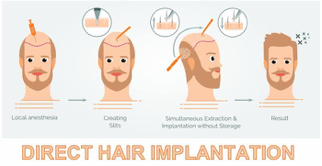It is a treatment that manually cuts channels in your scalp before implanting hair follicles. During DHI, they use a specialized pen-shaped tool that can do both at the same time.
ADVANTAGES
- Use of local anesthesia.
- It is not invasive, without pain, without hospitalization.
- It is not necessary to shave the reception area.
- There are different types of implants (larger or smaller diameter) depending on the characteristics of the patient’s follicle.
- It can give more density.
- It has more precision and accuracy.
- The scalp and surrounding follicles are almost untouched.
- It is not necessary to use the scalpel to open the channels where the follicles will be deposited, so the wound is smaller and leaves no scars; With the implanter, it is easier and more convenient to control the tilt angle, depth and direction of the channel.
- Patients can have a normal life right out.
- Natural and permanent finishes.

POSSIBLE RISKS
- crust or pus drainage around the surgical sites
- scalp pain, itching, and swelling
- inflammation of hair follicles (folliculitis)
- bleeding
- losing sensation around the surgical sites
- visible areas of hair that don’t match the surrounding hair or are noticeably thinner
- continuing to lose hair if your hair is still balding
- Infections
REQUIREMENTS
- Men who have hair loss caused by male pattern baldness
- Men who are classified as a Norwood Scale Class 3 or above
- Women, as well as men who wish to thicken their hair
- Men who want beard transplantation

PROCESS
DHI is a modified version of FUE hair implantation and follows a similar procedure. Your surgeon will remove hair follicles from a part of your scalp, usually the back of your head, and implant them into balding areas. These hair follicles will eventually grow new hairs.
- Your surgeon will shave your head and apply local anesthesia to numb it.
- The surgeon will extract hair follicles from the back of your head using a tool with a fine tip.
- The hair follicles will be loaded into a pen-shaped tool and implanted into the balding part of your scalp.
- The surgeon will apply an antibiotic cream and apply a bandage to all sites.
In your first week after the surgery, you may experience minor swelling and discomfort. Don’t panic, these are all okay and expected.
In your second week after hair transplant you may notice some redness in the donor and implanted area which is also normal and will disappear soon.
About 3 weeks after DHI treatment, you may notice the temporary loss of implanted hair. This is quite normal and expected.
After 3-4 months of the DHI hair transplant you will realize that implanted hair is growing slowly. Whole process of growing can take up to 16 months.
MOST ASKED QUESTIONS
Is DHI hair transplant painful?
During the procedure, you are more likely not to feel any sort of pain because your doctors would have given you local anesthesia. But soon after the procedure is done, you may feel discomfort or soreness. But the discomfort will be handled by the meds that the surgeon will prescribe to you after the surgery.
Does DHI Hair Transplant leave a scar?
This is probably one of the frequently asked questions by patients who are considering the DHI hair transplant. Well the answer is a big NO. When performed by hair transplants specialists (such as the team at Estepalace), DHI technique leaves no visible scars in both the donor and implanted area.
